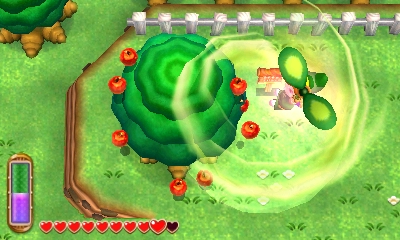The Legend of Zelda: A Link Between Worlds Review

Swift Pacing, Smooth Frame Rate, Focused, Non-linear structure.
Can be a bit easy at times, StreetPass features can spoil parts of the game.
New mechanics come without filler, familiar locales appear without much recycling in dungeons; The Legend of Zelda: A Link Between Worlds provides some of the sharpest adventuring the series has ever provided. Absolutely recommended.
A Link to the Best of Times
The Legend of Zelda: A Link Between Worlds (ALBW) gets so many elements of the Zelda formula exactly right, I start to wonder why all the extra fluff was ever in the series to begin with. Nothing gets between you and the quest, making for the purest adventure on the 3DS, and one of the best in Zelda series.
Story/Concept
The familiar kingdom of Hyrule enjoys years of peace after the events of A Link to the Past, only to be interrupted by the arrogant magician/artist Yuga. The antagonist begins turning villagers into paintings, including Princess Zelda, which throws the world into disarray. Mysterious motivations surface, and a new world is revealed to the people of Hyrule: a mirror version of the land called Lorule. After having slept in (as usual,) Link is thrown into action with the help of Ravio, a masked salesman who provides Link with the ability to become a painting at will. This ability becomes invaluable to solving the puzzles in and navigating the land of Hyrule. Link and Ravio make a deal to share Link’s house, in exchange for a full suite of rentable items that’ll help bring order back to the people of Hyrule.
Gameplay
ALBW manages to cut anything that ever got in the way of recent Zelda games, and gets back to the absolute necessities of the series. No longer is there a 3+ hour intro to slog through before seeing the first dungeon or waiting for most items, since almost all of them are available at the beginning. Puzzles can be cleverer, since progress through the game isn’t limited to when the game decides to give you an item. Everything moves at a fast, consistent pace, making ALBW one of the most liberating, and aggressive, Zelda’s since the first on the NES. Controlling Link feels good on the 3DS. The speed that the hero treads at is very comfortable, never feeling like the world is too big to walk around. Despite that, there IS a fast travel system that makes movement simple if you know where you’re going. Every animation is precisely adjusted to make action tight. Attack ranges, fall speeds and more all have a weight and punch that never feels slow or unresponsive. The new merge mechanic that lets Link attached to walls is activated with one button press, and it’s seamless.
Item rentals are one of the most unique new elements of the game, allowing players to rent any item and use it until they fall in battle. Having this access opens up the world immediately, rewarding smart players for experimenting, and letting new player dip thier toes in without having to commit to any one thing. Later on, the items can be purchase permanently and upgraded. Nothing is taxed though, don’t worry.
A bit of ingenuity comes with the use of the touch screen. When the subscreen is displayed, players can place pins to mark important locations, organize gear, or simply check an item’s use. As simple as it seems, that’s really all it needs to do, and it expedites item usage exponentially, just as it did in Wind Waker HD and Ocarina of Time 3D before it. Dungeoneering is swift and excellently paced, if a little on the easier side. New mechanics are constantly seeing use, and almost every item can get used several different ways. Each dungeon can be tackled in whatever order the player can handle them, and the game doesn’t even think to suggest an order; only a hint is given at each dungeon’s theme. The sheer number of labyrinths in the game reaches toward the record set by ALTTP, with interesting bosses in every single one. This is the first time in a while that I’ve been engaged by every boss in a Zelda game, and I think that’s a testament to the focused approach the game takes.
Not once did I feel like the title was telling me what to do, how to feel, or keeping me from finishing the game whenever or however I wanted. Short cutscenes and exposition are front and back loaded, and the game is (thankfully) very stingy with written hints throughout the journey. There’s a hint system, but it costs 3DS Play Coins to use and doesn’t remind you that it’s there every 5 seconds. Fi and Navi get to stay in the past. Everything in the game is at the service of the gameplay; if it could have gotten in the way, it’s either omitted or optional (unless you’re going for 100%.)
Graphics & Sound
ALBW looks as smooth as it plays. Running at 60 fps 99% of the time, everything looks fluid and feels natural. This frame rate sticks around even when the 3D is on, and the game has some of the best use of the 3DS’s titular feature, especially in the gameplay. Great lighting, subtle normal mapping and rich color paint landscapes that are familiar on the outside, and foreign on the inside. Nothing is wasted, and every technique is used to retain the game’s “neo-retro†look. The only thing that might be a minor blemish to some is the look of Link himself. He’s not ugly by any means, but the model is one of the more generic iterations of the character, and he might come off as lifeless some of the time. The animation certainly saves that, though. The presentation is full of references to Zelda’s past, making the game feel integrated with the series while carving out a new path for it.
Music is a mix of old and new, and all of it is played with live performers. The game has multiple memorable tracks, from the classic Kakariko Village to the new Maiamai theme. Sound effects hit hard and slap the speakers giving everything a satisfying, meaty thud or an assuring jingle to let you know “you’re doing it right.†This is definitely a game to play with all the sliders turned up, as it all makes the gameplay more enjoyable.
Multiplayer
The game features StreetPass functionality that lets you fight “Shadow Links†that are pre equipped versions of other players you pass by. Beating them earns money, and medals, that work much like achievements, with 50 in total. The feature is fun enough, but…
Issues
…it’s the ultimate compendium of spoilers. Items, moves, and other gear can get spoiled instantly because a player had gotten further into the game than you. My recommendation is actually to avoid the feature until the near end of the adventure, if you care anything about the surprises the items provide. Other than that, the other few problems have to do with a couple of items that don’t have enough uses outside of minigames, and the general ease of some of the puzzle solving. It’s not too easy, but I found myself forgetting parts of dungeons because I near brainlessly solved them.
Notable Extras
There are tons of extra items and minigames hidden all over the map, and the StreetPass challenges to complete. Not every item is necessary, but they all work together to make playing in the field more enjoyable.
Upon completion of the game, the now common Hero Mode is unlocked, which raises the combat difficulty and features a few minor extras within the main quest. It’s a nice challenge, though I would enjoy if every Zelda from now on had it unlocked from the beginning like Wind Waker HD. It actually makes the game’s economy even more significant and shielding more necessary.
Spawnfirst Recommends…
Whether you’ve played Zelda before or not, this game is absolutely worth jumping into. Everything serves the adventure to make it more fun, more consistent, and less tedious than many of the recent Zelda games. New mechanics without filler, familiar locales without much recycling in dungeons, The Legend of Zelda: A Link Between Worlds provides some of the sharpest adventuring the series has ever seen. Absolutely recommended.














